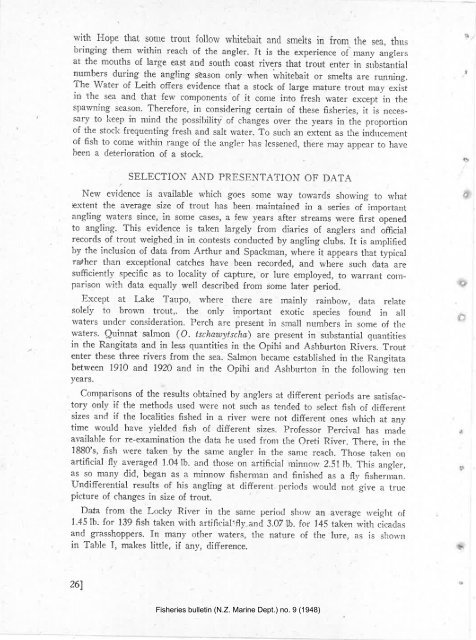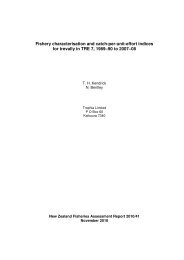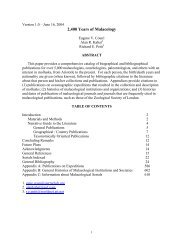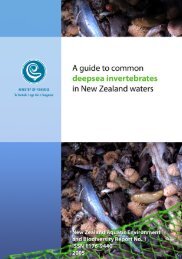N.Z. MARINE DEPARTMENT-FISHERIE,S BULLETIN No. .į
N.Z. MARINE DEPARTMENT-FISHERIE,S BULLETIN No. .į
N.Z. MARINE DEPARTMENT-FISHERIE,S BULLETIN No. .į
Create successful ePaper yourself
Turn your PDF publications into a flip-book with our unique Google optimized e-Paper software.
with Hope that some trout follow whitebait ancl smelts in from the sea, thrrs<br />
bringing them within reach of the angler. It is the experience of many ar.rglels<br />
at the mouths of large east and south coast rivers that trout enter ilr substantial<br />
nrrmbers during the angling season only when *hit"b"it or smelts are running.<br />
The \Mater of Leith offers evidence that a stock of large mature trout may exist<br />
in rthe sea and that few components of it come into fresh water except i¡ the<br />
spawning seaso11. Therefore, in considering certain of these fisheries, it is necessary<br />
to lieep in mind the possibility of changes over the years in the proportion<br />
of the stock frequenting fresh ar-rcl salt water. To such an extent as the indrrcer¡ent<br />
of fish to come within range of the anglel has lessenecl, there may appear to have<br />
been a cleterioration of a stock.<br />
SELECTION AND PRESENTATION Otr DATA<br />
New evidence is available which goes some way towards showing to what<br />
extent the average size of trout has been maintained in a series of important<br />
angling waters since, in some cases, a few years after streams were first openecl<br />
to angling. This evidence is taken largely from diaries of anglers and official<br />
recorcls of trout weighed in in contests conducted by angling clubs. It is arirplified<br />
by the inclusion of data from Arthur and Spackrnan, where it appears that typical<br />
rarther than exceptional catches have been lecorded, and where such data are<br />
sufiñciently specific as to locality of capture, or lure employed, to warrant colrrparison<br />
with data equally well described from some later period.<br />
Except at Lake Taupo, where there are rnainly rainbow, clata relate<br />
solely to brown trout,. the only important exotic species founcl in all<br />
waters uncler consideration. Perch are present in small nurnbers in some of the<br />
waters. Qtrinnat salmon (O. tsch,azuytscltø) are present in substantial quantities<br />
in the Rangitata and in less quantities in the Opihi ancl Ashburto¡ Rivers. Trout<br />
enter these three rivers from the sea. Salmon became established in the Rangitata<br />
between 1910 and 1920 and in the Opihi and Ashburton in the follorving ten<br />
years.<br />
Conrparisons of the results obtaine







